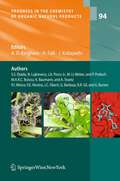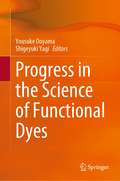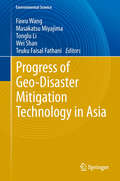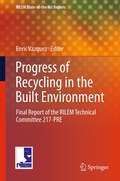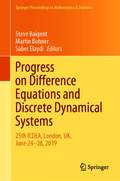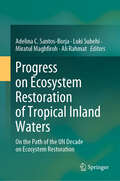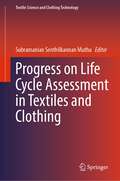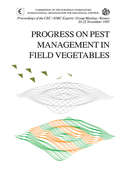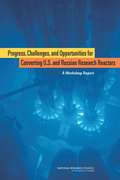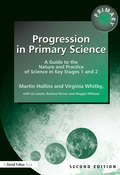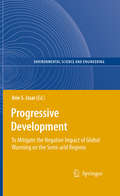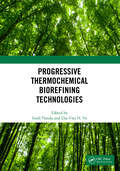- Table View
- List View
Progress in the Chemistry of Organic Natural Products 109 (Progress in the Chemistry of Organic Natural Products #109)
by A. Douglas Kinghorn Heinz Falk Simon Gibbons Yoshinori Asakawa Jun’ichi Kobayashi Ji-Kai LiuThis volume comprises three reviews. The first describes isolation, structure determination, syntheses, and biochemistry of the low molecular weight compounds of the secretion of exocrine glands of termies with emphasis to pheromones and defensive compounds. The second review describes recent studies on isolation and structure elucidation of bioactive compounds involved in the life cycle and determination of the molecular mechanisms of the developmental events observed in higher plants. The third contribution reports on the current body of knowledge of African propolis, with a particular emphasis on its chemistry and biological activity.
Progress in the Chemistry of Organic Natural Products 110: Cheminformatics in Natural Product Research (Progress in the Chemistry of Organic Natural Products #110)
by A. Douglas Kinghorn Heinz Falk Simon Gibbons Yoshinori Asakawa Jun’ichi Kobayashi Ji-Kai LiuThe book summarizes important aspects of cheminformatics that are relevant for natural product research. It highlights cheminformatics tools that help to match natural products with their respective biological targets or off-targets, and discusses the potential and limitations of this approach.
Progress in the Chemistry of Organic Natural Products 111 (Progress in the Chemistry of Organic Natural Products #111)
by A. Douglas Kinghorn Heinz Falk Simon Gibbons Yoshinori Asakawa Jun’ichi Kobayashi Ji-Kai LiuThe first chapter in volume 111 summarizes research on the sesterterpenoids, which are known as a relatively small group of natural products. However, they express a variety of simple to complicated chemical structures. This chapter focuses on the chemical structures of sesterterpenoids and how their structures are synthesized in Nature. The second chapter is devoted to marine-derived fungi, which play an important role in the search for structurally unique secondary metabolites, some of which show promising pharmacological activities that make them useful leads for drug discovery. Marine natural product research in China in general has made enormous progress in the last two decades as described in this chapter on fungal metabolites. This contribution covers 613 new natural products reported from 2001 to 2017 from marine-derived fungi obtained from algae, sponges, corals, and other marine organisms from Chinese waters.
Progress in the Chemistry of Organic Natural Products 112 (Progress in the Chemistry of Organic Natural Products #112)
by A. Douglas Kinghorn Heinz Falk Simon Gibbons Yoshinori Asakawa Jun’ichi Kobayashi Ji-Kai LiuThe first chapter describes the oldest method of communication between living systems in Nature, the chemical language. Plants, due to their lack of mobility, have developed the most sophisticated way of chemical communication. Despite that many examples involve this chemical communication process - allelopathy, there is still a lack of information about specific allelochemicals released into the environment, their purpose, as well as in-depth studies on the chemistry underground. These findings are critical to gain a better understanding of the role of these compounds and open up a wide range of possibilities and applications, especially in agriculture and phytomedicine. The most relevant aspects regarding the chemical language of plants, namely, kind of allelochemicals have been investigated, as well as their releasing mechanisms and their purpose, are described in this chapter. The second chapter is focused on the natural products obtained from Hypericum L., a genus of the family Hypericaceae within the dicotyledones. Hypericum has been valued for its important biological and chemical properties and its use in the treatment of depression and as an antibacterial has been well documented in primary literature and ethnobotanical reports. The present contribution gives a comprehensive summary of the chemical constituents and biological effects of this genus. A comprehensive account of the chemical constituents including phloroglucinol derivatives, xanthones, dianthrones, and flavonoids is included. These compounds show a diverse range of biological activities that include antimicrobial, cytotoxic, antidepressant-like, and antinociceptive effects. The third chapter addresses microtubule stabilizers, which are a mainstay in the treatment of many solid cancers and are often used in combination with molecularly targeted anticancer agents and immunotherapeutics. The taccalonolides are a unique class of such microtubule stabilizers isolated from plants of Tacca species that circumvent clinically relevant mechanisms of drug resistance. Although initial reports suggested that the microtubule stabilizing activity of the taccalonolides is independent of direct tubulin binding, additional studies have found that potent C-22,23 epoxidated taccalonolides covalently bind the Aspartate 226 residue of β-tubulin and that this interaction is critical for their microtubule stabilizing activity. Some taccalonolides have demonstrated in vivo antitumor efficacy in drug-resistant tumor models with exquisite potency and long-lasting antitumor efficacy as a result of their irreversible target engagement. The recent identification of a site on the taccalonolide scaffold that is amenable to modification has provided evidence of the specificity of the taccalonolide-tubulin interaction and the opportunity to further optimize the targeted delivery of the taccalonolides to further improve their anticancer efficacy and potential for clinical development.
Progress in the Chemistry of Organic Natural Products 113 (Progress in the Chemistry of Organic Natural Products #113)
by A. Douglas Kinghorn Heinz Falk Simon Gibbons Yoshinori Asakawa Jun’ichi Kobayashi Ji-Kai LiuIn this book, chemical studies are described mainly from literature reports appearing since 2000, inclusive of investigations performed by the present authors, on the diversity in secondary metabolites of Ligularia growing in the Hengduan Mountains area of China, focusing on eremophilane sesquiterpenoids and other metabolites. More than 100 Ligularia species and their related genera in the plant family Senecioneae plants (Cremanthodium, Cacalia, Senecio, and others) grow in East Asia. For many years, researchers have studied the chemical constituents of these plants, and terpenoids, flavonoids, steroids, alkaloids, and aromatic compounds have been isolated. Among these, in particular, numerous sesquiterpenoids were reported. Within this book terpenoids and aromatic compounds (total 1049), both previously unknown and known, are presented. Finally, genetic studies and synthesis investigations are briefly reviewed.
Progress in the Chemistry of Organic Natural Products 114 (Progress in the Chemistry of Organic Natural Products #114)
by A. Douglas Kinghorn Heinz Falk Simon Gibbons Yoshinori Asakawa Jun’ichi Kobayashi Ji-Kai LiuThis book describes current understandings and recent progress in four areas: in the first one, the cytochalasans, a group of fungal derived natural products characterized by a perhydro-isoindolone core fused with a macrocyclic ring are shown to exhibit high structural diversity and a broad spectrum of bioactivities. The second one is dedicated to a description of bioactive compounds from the medicinal plants of Myanmar, the third one is dedicated to new structure elucidation techniques in the field of sesquiterpenes. The last one discusses the endogenous natural products that are produced by human cells including endogenous amines, steroids, and fatty acid derived natural products. The co-metabolism and natural product production of the human microbiome is also described including tryptophan, bile acids, choline, and cysteine.
Progress in the Chemistry of Organic Natural Products 115 (Progress in the Chemistry of Organic Natural Products #115)
by A. Douglas Kinghorn Heinz Falk Simon Gibbons Yoshinori Asakawa Ji-Kai Liu Verena M. DirschThis book describes current understandings and recent progress into a varied group of natural products. In the first chapter the role that total synthesis may play in revising the structures proposed for decanolides, which are ten-membered lactones found primarily in fungi, frogs, and termites is presented. The following chapter presents the development of the intriguing plant-derived sesquiterpene lactone, thapsigargin, a potent inhibitor of the enzyme, SERCA (sarco-endoplasmic Ca2+ ATPase), which has potential as a lead compound to treat cancer. The third chapter covers the potential of various plant phenolic compounds for treating the tropical and sub-tropical infectious disease, leishmaniasis. In addition the volume presents recent advances related to the plant alkaloid, cryptolepine, which is of particular interest as a lead for the treatment of malaria, trypanosomiasis, and cancer.
Progress in the Chemistry of Organic Natural Products 116 (Progress in the Chemistry of Organic Natural Products #116)
by A. Douglas Kinghorn Heinz Falk Simon Gibbons Yoshinori Asakawa Ji-Kai Liu Verena M. DirschThis volume describes several highly diverse subjects: Chapter 1 explores marine biodiscovery of the North-eastern Atlantic off the coast of Ireland as a model for best practice in research. The second chapter investigates Brazilian Chemical Ecology and examples of insect-plant communication studies that are mediated by natural products demonstrate the beautiful interconnectedness of species in a biome. Our third chapter comprises the advances in the science of the sesquiterpene quinone, perezone, which in 1852 was the first natural product isolated in crystalline form in the New World. The last two chapters are from a Vietnamese group and the first of these follows the phytochemistry, pharmacology, and ethnomedical uses of the genus Xanthium, which produces interesting sulfur and nitrogen containing natural products. Finally, the genus Desmos is discussed, where an overview of its constituent natural products and their in vitro pharmacological potential is described.
Progress in the Chemistry of Organic Natural Products 118 (Progress in the Chemistry of Organic Natural Products #118)
by A. Douglas Kinghorn Heinz Falk Simon Gibbons Yoshinori Asakawa Ji-Kai Liu Verena M. DirschThis volume consists of four chapters that cover a structurally diverse range of naturally occurring compounds. Chapter 1 delves into the chemistry of pyrogallols and their oxidized products, the hydroxy-o-quinones, including their role in cycloaddition reactions in the chemical synthesis of several fungal metabolites. Chapter 2 provides an in-depth description of the constituents of agarwood essential oil and smoke samples that are used in the perfumery industry, with an emphasis on the sesquiterpenoid and chromones constituents so far known. Chapter 3 discusses the defensive chemical ecology of two North American newt species that both produce tetrodotoxin, a well-known neurotoxin that causes paralysis and death in metazoans by disrupting electrical signals in the nerves and muscles. Chapter 4 discusses the limonoids and triterpenoids from the genus Walsura of the plant family Meliaceae, of which a number of species are utilized in several southeastern Asian countries in systems of folk medicine.
Progress in the Chemistry of Organic Natural Products 122: Botanical Dietary Supplements and Herbal Medicines (Progress in the Chemistry of Organic Natural Products #122)
by A. Douglas Kinghorn Heinz Falk Simon Gibbons Yoshinori Asakawa Ji-Kai Liu Verena M. DirschThis volume highlights some recent developments on plants used widely as botanical dietary supplements and herbal medicines, especially in terms of knowledge of the chemical types and diverse biological activities of their constituents, as well as laboratory approaches for their quality control and taxonomic identification. In the first chapter, the biologically active secondary metabolites are described of selected botanicals that have a wide current use in the United States, with recent information provided also on their in vitro and in vivo biological activities. The second chapter constitutes an updated survey of the different chromatographic, spectroscopic, and metabolomics techniques that can be utilized for the quality control of botanical products. The penultimate chapter covers different nomenclatural systems that are of use for the taxonomic identification of source plants used in botanical products. Finally, deoxyribonucleic acid molecular barcoding techniques for the identification for plants used as dietary supplements are covered.
Progress in the Chemistry of Organic Natural Products 124 (Progress in the Chemistry of Organic Natural Products #124)
by A. Douglas Kinghorn Heinz Falk Simon Gibbons Yoshinori Asakawa Ji-Kai Liu Verena M. DirschThis volume presents three chapters discussing a range of topics. Chapter 1 deals with the development of efficient methods for compound dereplication that have been critical in the re-emergence of research on natural products as a source of new drug leads. It describes the main methods of dereplication, which rely on the combined use of large natural product databases and spectral libraries, alongside the information obtained from chromatographic, UV-Vis, MS, and NMR spectroscopic analyses of the samples of interest. Chapter 2 describes 989 plant natural products and their ecological functions in plant-herbivore, plant-microorganism, and plant-plant interactions. These compounds include alkaloids, phenols, terpenoids, and other structural types. The information presented should provide the basis for in-depth research on these plant natural products and their natural functions, and also for their further development and utilization. Chapter 3 focuses on lichens, with each constituting a symbiotic association composed of a primary mycobiont and one or more photobionts living mutualistically. Covered are lichens and their bionts, taxonomic identification, and their chemical constituents as exemplified by what is found in lichen biomes, especially those endemic to North America. Extraction and isolation procedures, as well as updates on dereplication methods using mass spectrometric GNPS and NMR spectroscopic spin network fingerprint procedures, and marker-based techniques to identify lichens are discussed. The isolation and structure elucidation of secondary metabolites of an endolichenic Penicillium species that produces bioactive compounds is described in detail.
Progress in the Chemistry of Organic Natural Products 99
by A. Douglas Kinghorn H. Falk J. KobayashiThe volumes of this classic series, now referred to simply as "Zechmeister" after its founder, Laszlo Zechmeister, have appeared under the Springer Imprint ever since the series' inauguration in 1938. The series has featured contributions by seven Nobel laureates: D. H. R. Barton, D. Crowfoot Hodgkin, L. Pauling, K. Alder, O. Diels, P. Karrer, H. von Euler-Chelpin. The volumes contain contributions on various topics related to the origin, distribution, chemistry, synthesis, biochemistry, function or use of various classes of naturally occurring substances ranging from small molecules to biopolymers. Each contribution is written by a recognized authority in the field and provides a comprehensive and up-to-date review of the topic in question. Addressed to biologists, technologists, and chemists alike, the series can be used by the expert as a source of information and literature citations and by the non-expert as a means of orientation in a rapidly developing discipline.
Progress in the Chemistry of Organic Natural Products Vol. 94
by A. Douglas Kinghorn Heinz Falk Junichi KobayashiThe three reviews cover the advances in the chemistry and biology of withanolides over the last 16 years, review the chemistry and biology of the rocaglamide-type derivatives and related compounds, with emphasis on their structural diversity, biosynthesis, pharmacological significance and total synthesis, and summarize the extensive chemistry and biology studies on a natural product, which have resulted in a novel therapy approved worldwide.
Progress in the Science of Functional Dyes
by Yousuke Ooyama Shigeyuki YagiThis book covers a wide range of topics related to functional dyes, from synthesis and functionality to application. Making a survey of recent progress in functional dye chemistry, it provides an opportunity not only to understand the structure-property relationships of a variety of functional dyes but also to know how they are applied in practical use, from electronic devices to biochemical analyses. From classic dyes such as cyanines, squaraines, porphyrins, phthalocyanines, and others to the newest functional π-conjugation systems, various types of functional dyes are dealt with extensively in the book, focusing especially on the state of the art and the future. Readers will benefit greatly from the scientific context in which organic dyes and pigments are comprehensively explained on the basis of chemistry.
Progress of Geo-Disaster Mitigation Technology in Asia
by Tonglu Li Fawu Wang Wei Shan Masakatsu Miyajima Teuku Faisal FathaniThis book includes the recent 10-year achievement of geo-disaster mitigation by leading Asian scientists from Japan, China, Indonesia, Korea, Iran and Far East of Russia. Case studies on recent occurred geo-disasters in Asian region have been presented. The forming mechanics of hazards such as earthquake and landslide are deeply discussed, and the disaster mitigation technology for building and pipeline safety, landslide hazard assessment and risk management are introduced.
Progress of Recycling in the Built Environment
by Enric VázquezThis report is a useful tool for countries starting to recycle aggregates or construction and demolition waste. It contains the latest developments in this field, introduces a completely new approach to the procedure of proportioning concrete mixtures with recycled aggregate, references recent publications, opinions and discrepancies in relation to the durability of recycled concrete, such as freeze-thaw standards, studies of chloride penetration and diffusion, and sulfate attacks, the use of the fine fraction <4mm, quality assurance of concrete recycled aggregate, sustainability and recycling construction waste and global impact assessment of urban renewal based on sustainable recycling strategies for construction and demolition waste. This volume will be of interest to recyclers, researchers and consumers.
Progress on Difference Equations and Discrete Dynamical Systems: 25th ICDEA, London, UK, June 24–28, 2019 (Springer Proceedings in Mathematics & Statistics #341)
by Martin Bohner Saber Elaydi Steve BaigentThis book comprises selected papers of the 25th International Conference on Difference Equations and Applications, ICDEA 2019, held at UCL, London, UK, in June 2019. The volume details the latest research on difference equations and discrete dynamical systems, and their application to areas such as biology, economics, and the social sciences. Some chapters have a tutorial style and cover the history and more recent developments for a particular topic, such as chaos, bifurcation theory, monotone dynamics, and global stability. Other chapters cover the latest personal research contributions of the author(s) in their particular area of expertise and range from the more technical articles on abstract systems to those that discuss the application of difference equations to real-world problems. The book is of interest to both Ph.D. students and researchers alike who wish to keep abreast of the latest developments in difference equations and discrete dynamical systems.
Progress on Ecosystem Restoration of Tropical Inland Waters: On the Path of the UN Decade on Ecosystem Restoration
by Adelina C. Santos-Borja Luki Subehi Miratul Maghfiroh Ali RahmatThis book explores the current ecosystem status of tropical inland waters especially in Southeast Asia, the progress of ecosystem restoration in terms of current studies, technological interventions, policy recommendations, and stakeholder participation that gives due respect to traditional knowledge and cultural practices, and the challenges and opportunities of the restoration processes. The UN Decade on Ecosystem Restoration and the UN Environment Assembly’s Resolution on Sustainable Lake Management were the motive force in the publication of the book. Inland waters provide humans and a myriad of organisms with tremendous benefits. However, changing inland water environment due to external and internal pressures leads to unfortunate events such as water degradation, loss of biodiversity, and destruction of ecosystems with serious socio-economic consequences. This book serves as a good reference for students, academia, practitioners and other professionals, policy makers, and other stakeholders. The updated data and information on various aspects of ecosystem restoration, sustainable management, and utilization of inland waters contribute to understanding how ecosystem restoration of tropical inland water progresses in a changing environment. The book includes multidisciplinary and insightful information on tropical inland waters in line with the UN Decade of Ecosystem Restoration in 2021.
Progress on Life Cycle Assessment in Textiles and Clothing (Textile Science and Clothing Technology)
by Subramanian Senthilkannan MuthuTextiles and Clothing are key sectors and apparel is one of the necessities of human life. Environmental brunt of the textile sector and cradle to grave life cycle impacts of textiles and clothing products are a subject of constant investigation. There have been a lot of advancements in the textile sector in terms of materials such as textile fibres, yarns, fabrics, garments and also in terms of processes. All these innovations demand an environmental profile as well. Life Cycle Assessment is one of the widely used and popular scientific tools which has been utilized to measure the environmental footprints of various products and processes. This volume presents recent advances on LCA in the textiles and clothing sector.
Progress on Pest Management in Field Vegetables
by R. CavalloProceedings of the CEC/IOBC Expert's Group Meeting, Pennes, France, November 1985. Forty contributions (authors are from 12 countries and two international organizations) deal with crops such as cabbages, carrots, tomatoes, potatoes, beans, and artichokes and with the particularly urgent task of red
Progress, Challenges, and Opportunities for Converting U.S. and Russian Research Reactors
by Challenges U.S. Committee on Progress Opportunities for Converting U.S. Russian Reactors from Highly Enriched to Low Enriched Uranium FuelHighly enriched uranium (HEU) is used for two major civilian purposes: as fuel for research reactors and as targets for medical isotope production. This material can be dangerous in the wrong hands. Stolen or diverted HEU can be used-in conjunction with some knowledge of physics-to build nuclear explosive devices. Thus, the continued civilian use of HEU is of concern particularly because this material may not be uniformly well-protected. To address these concerns, the National Research Council (NRC) of the U. S. National Academies and the Russian Academy of Sciences (RAS) held a joint symposium on June 8-10, 2011. Progress, Challenges, and Opportunities for Converting U. S. and Russian Research Reactors summarizes the proceedings of this joint symposium. This report addresses: (1) recent progress on conversion of research reactors, with a focus on U. S. - and R. F. -origin reactors; (2) lessons learned for overcoming conversion challenges, increasing the effectiveness of research reactor use, and enabling new reactor missions; (3) future research reactor conversion plans, challenges, and opportunities; and (4) actions that could be taken by U. S. and Russian organizations to promote conversion. The agenda for the symposium is provided in Appendix A, biographical sketches of the committee members are provided in Appendix B, and the report concludes with the statement of task in Appendix C.
Progress: Geographical Essays
by Robert David Sack"The connection between geography and progress is fundamental," writes Robert Sack in the introduction to the present volume. Touching on both moral and material progress, six of the world's leading geographers and environmental historians explore differing aspects of this connection. Thomas Vale discusses whether progress is discernible in the natural realm; Kenneth Olwig examines fundamental changes that occurred to the notion of progress with the rise of modernity, while David Lowenthal and Yi-Fu Tuan discuss recent geographical changes that have resulted in an increasing societal disenchantment and anxiety. Nicholas Entrikin looks at progress as "moral perfectibility, and its connection to democratic places," a theme which Robert Sack further explores by prescribing ways in which geographers and citizens can evaluate and create places that increase our awareness of reality in its variety and complexity.Contributors: J. Nicholas Entrikin, University of California-Los Angeles; David Lowenthal, University College, London; Kenneth Olwig, University in Trondheim, Norway; Robert David Sack, University of Wisconsin-Madison; Yi-Fu Tuan, University of Wisconsin-Madison; Thomas R. Vale, University of Wisconsin-Madison.
Progression in Primary Science: A Guide to the Nature and Practice of Science in Key Stages 1 and 2
by Martin Hollins Maggie Williams Virginia WhitbyUsing many examples drawn from classroom practice, this guide supports and aims to extend the student teacher's own subject knowledge and understanding of science in the context of the primary classroom. It offers an accessible guide to all the main concepts of Key Stages one and two science teaching. Illustrating the importance of issues such as resourcing and assessing science in the primary classroom, the book offers guidance for practicing teachers who consider themselves "non-specialists" in science.
Progressive Development
by Arie S. IssarThe book is based on the results of the investigations of the authors in the semi-arid and arid regions (ASAR) of the globe. These investigations brought to the conclusion that the warming climate will cause the drying up of the water resources in these regions. In this case the principles of Sustainable Development will not be able to avert forthcoming catastrophes. These conclusions brought to the compilation of the policy of "Progressive Development", emphasising investment in the development of new water resources and changing the natural environments while advancing the local populations on the dimension of knowledge by education.
Progressive Thermochemical Biorefining Technologies
by Sonil Nanda; Dai-Viet N. VoConsidering the deleterious impacts of fossil fuels on the environmental and natural ecosystems, it has become imperative to make a paradigm shift toward renewable fuels, chemicals, and materials. The exhaustive everyday usage of fossil fuels and processed petrochemical products are the leading causes for the increase in greenhouse gas emissions, global warming, climate changes, acid rain, ozone layer depletion, pollution of air, water, and soil as well as for the accumulation of nonbiodegradable materials in the soil and oceans. On the contrary, biofuels, biochemicals, and biomaterials derived from renewable wastes such as nonedible plant biomass (e.g., agricultural and forestry biomass), energy crops, microalgae, municipal solid waste, sewage sludge, and other biogenic residues seem to be carbon neutral. Therefore, the global interest in biorefining technologies, especially thermochemical and biological conversion processes, is gaining momentum in academic and industrial perspectives. Progressive Thermochemical Biorefining Technologies offers all-inclusive coverage of the most crucial topics as follows: State-of-the-art information on the production and utilization of biofuels through thermochemical biorefining technologies Conversion of waste biomass through pyrolysis, liquefaction, torrefaction, carbonization, gasification, reforming, and other clean technologies Waste-to-energy/chemical generation Fuel upgrading technologies Techno-economic analysis and life-cycle assessment of biorefining processes Specifically designed to be instantly applicable, this volume serves as a reference book for undergraduate and graduate students, scientific investigators, and research scholars working in the areas relating to energy and fuels.












